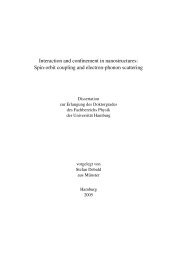Measuring the Electron Beam Energy in a Magnetic Bunch ... - DESY
Measuring the Electron Beam Energy in a Magnetic Bunch ... - DESY
Measuring the Electron Beam Energy in a Magnetic Bunch ... - DESY
Create successful ePaper yourself
Turn your PDF publications into a flip-book with our unique Google optimized e-Paper software.
PMT<br />
BBO<br />
GDD<br />
PMT<br />
Two laser<br />
pulses:<br />
800 nm<br />
1550 nm<br />
Figure 3.4.1 Measurement of <strong>the</strong> arrival-time of <strong>the</strong> <strong>in</strong>jector laser pulse relative to a<br />
tim<strong>in</strong>g laser reference (MLO) us<strong>in</strong>g a two-color s<strong>in</strong>gle-crystal balanced<br />
optical cross-correlator. From S. Schulz, Synchronization of Injector Laser<br />
and Master Laser Oscillator PAC’10.<br />
In Fig. 3.4.1, <strong>the</strong> arrival-time of <strong>the</strong> <strong>in</strong>jector laser pulse is measured relative to <strong>the</strong> optical<br />
reference laser <strong>in</strong> an optical cross-correlator. In a two-color optical cross-correlator, two<br />
laser pulses with different colors (800 nm and 1550 nm) are sent through a dichroic<br />
mirror that reflects <strong>the</strong> sum frequency (527.7 nm) and transmits <strong>the</strong> higher frequencies.<br />
The <strong>in</strong>put laser pulses are <strong>the</strong>n sent through a BBO crystal. When <strong>the</strong> pulses overlap <strong>in</strong><br />
<strong>the</strong> crystal, new pulses with <strong>the</strong> sum frequency are generated and emitted <strong>in</strong> both forward<br />
and backward directions. With <strong>the</strong> aid of dichroic mirrors and a group delay generated <strong>in</strong><br />
a dispersive medium, <strong>the</strong> pulses generated <strong>in</strong> <strong>the</strong> crystal each travel to a photomultiplier<br />
tube (PMT). The <strong>in</strong>com<strong>in</strong>g laser pulses return from whence <strong>the</strong>y came. In this balanced<br />
detection arrangement, <strong>the</strong> measurement of <strong>the</strong> relative arrival-times of <strong>the</strong> two <strong>in</strong>put<br />
pulses is <strong>in</strong>sensitive to laser noise and is background and drift free.<br />
3.5 Third-harmonic Module Jitter<br />
The third-harmonic module is comprised of 4 cell cavities which are filled with 3.9 GHz.<br />
It is used to l<strong>in</strong>earize <strong>the</strong> energy chirp of <strong>the</strong> beam. In <strong>the</strong> first bunch compressor, <strong>the</strong><br />
energy of an electron at position z <strong>in</strong> <strong>the</strong> bunch is<br />
E<br />
Dichroic mirror:<br />
Reflects<br />
527.7 nm<br />
Transmits<br />
800 and 1550nm<br />
BBO crystal:<br />
second harmonic<br />
light generated<br />
when pulses<br />
overlap.<br />
= E0<br />
+ V1<br />
cos( krf z + Φ1)<br />
+ V3<br />
cos(3k<br />
rf<br />
z +<br />
3)<br />
(3.5.1)<br />
1<br />
Φ<br />
GDD:<br />
Generate a<br />
group delay <strong>in</strong><br />
a dispersive<br />
medium<br />
Dichroic mirror:<br />
Transmits<br />
527.7 nm<br />
Reflects<br />
800 and 1550nm<br />
where (V 1 , Φ 1 , V 3 , Φ 3 ) are <strong>the</strong> RF amplitudes and phases of <strong>the</strong> first accelerator section<br />
and <strong>the</strong> third- harmonic module. As <strong>in</strong> Eq. 1.7, <strong>the</strong> path-length through <strong>the</strong> chicane as a<br />
function of <strong>the</strong> energy of a given particle is written by<br />
32

















